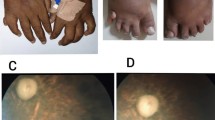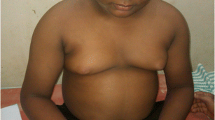Abstract
BACKGROUND AND AIM: Bardet-Biedl syndrome (BBS) is a rare autosomal recessive genetic disorder. We aimed to report a case series of Bardet-Biedl syndrome in a Turkish family and review the literature. PATIENTS AND METHODS: This family had 3 females and 4 males, totally 7 alive; 2 children (1 female and 1 male) had died. Parents were consanguineous. The first was a birth of twins and female sibling of these twins had congenital anal atresia and died when she was three-month old. Third (30 yr), 4th (28 yr) and 9th (19 yr) alive siblings were obese, blind and diabetic. We detected truncal obesity, postaxial polydactyly, cognitive impairment and hypogonadism. Rod-cone dystrophy was detected in ophthalmic examination. With these typical clinical findings, BBS was diagnosed. There was also a male member of the family which shared the same features of his affected brothers but he had died while he was eight months old. Marked glycosuria was determined and urine density was 1021 g/cm3. There was not any further endocrinological abnormality. Fasting blood glucose levels were changing between 290 and 452 mg/dl and the last glycated hemoglobine levels (A1c) were 9.3%, 11.2% and 12.8%, respectively. Diabetes mellitus and obesity were treated with diet, exercise, multiple daily insulin injections and metformine at the dose of 2000 mg/d. CONCLUSIONS: Although it is an infrequent condition due to autosomal recessive transmission, consanguineous marriage may increase the risk of emergence of BBS. Genetic counseling is a very important issue in the family of patients with BBS, in order to prevent new cases.
Similar content being viewed by others
References
Beales PL, Elcioglu N, Woolf AS, et al. New criteria for improved diagnosis of Bardet-Biedl syndrome: results of a population survey. J Med Genet 1999; 36: 437–46.
Croft JB, Morrell D, Chase CL et al. Obesity in heterozygous carriers of the gene for the Bardet-Biedl syndrome. Am J Med Genet 1995; 55: 12–5.
Green JS, Parfrey PS, Harnett JD, et al. The cardinal manifestations of Bardet-Biedl syndrome, a form of Laurence-Moon-Biedl syndrome. N Engl J Med 1989; 321: 1002–9.
Moore SJ, Green JS, Fan Y, et al. Clinical and genetic epidemiology of Bardet-Biedl syndrome in Newfoundland: a 22-year prospective, populationbased, cohort study. Am J Med Genet 2005; 132: 352–60.
Teebi AS. Autosomal recessive disorders among Arabs: an overview from Kuwait. J Med Genet 1994; 31: 224–33.
Hjortshøj TD, Grønskov K, Brøndum-Nielsen K, et al. A novel founder BBS1 mutation explains a unique high prevalence of Bardet-Biedl syndrome in the Faroe Islands. Br J Ophthalmol 2009; 93: 409–13.
Beales PL, Katsanis N, Lewis RA, et al. Genetic and mutational analyses of a large multiethnic Bardet-Biedl cohort reveal a minor involvement of BBS6 and delineate the critical intervals of other loci. Am J Hum Genet 2001; 68: 606–16.
Tobin JL, Beales PL. Bardet-Biedl syndrome: beyond the cilium. Pediatr Nephrol 2007; 22: 926–36.
Leitch CC, Zaghloul NA, Davis EE, et al. Hypomorphic mutations in syndromic encephalocele genes are associated with Bardet-Biedl syndrome. Nat Genet 2008; 40: 443–8.
Stoetzel C, Laurier V, Davis EE, et al. BBS10 encodes a vertebrate-specific chaperonin-like protein and is a major BBS locus. Nat Genet 2006; 38: 521–4.
Hjortshøj TD, Grønskov K, Philp AR, et al. Novel mutations in BBS5 highlight the importance of this gene in non-Caucasian Bardet-Biedl syndrome patients. Am J Med Genet A 2008; 146A: 517–20.
Woods CG, Cox J, Springell K, et al. Quantification of homozygosity in consanguineous individuals with autosomal recessive disease. Am J Hum Genet 2006; 78: 889–96.
Waters AM, Beales PL. Bardet-Biedl Syndrome. In: Pagon RA, Bird TC, Dolan CR, et al. (Eds) Gene Reviews [Internet]. Seattle (WA): University of Washington, Seattle, 1993–2003 Jul 14.
Katsanis N, Ansley SJ, Badano JL, et al. Triallelic inheritance in Bardet-Biedl syndrome, a Mendelian recessive disorder. Science 2001; 293: 2256–9.
Author information
Authors and Affiliations
Corresponding author
Rights and permissions
About this article
Cite this article
Bahceci, M., Dolek, D., Tutuncuoglu, P. et al. A case series of Bardet-Biedl Syndrome in a large Turkish family and review of the literature. Eat Weight Disord 17, e66–e69 (2012). https://doi.org/10.1007/BF03325331
Received:
Accepted:
Published:
Issue Date:
DOI: https://doi.org/10.1007/BF03325331




